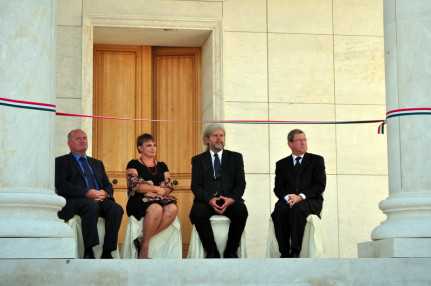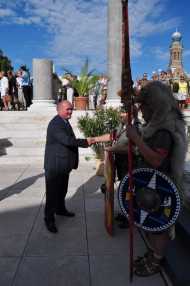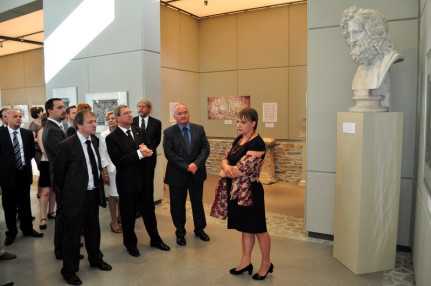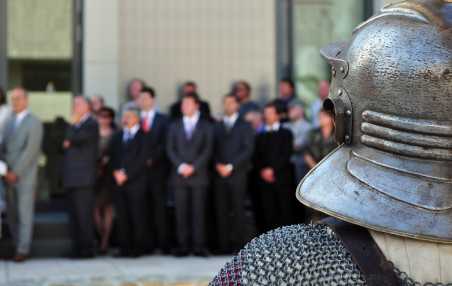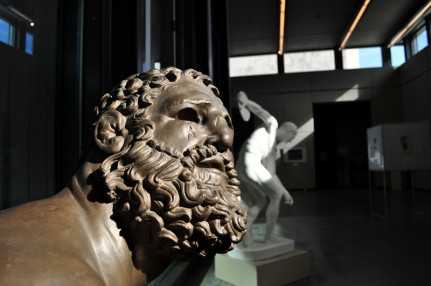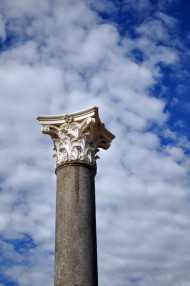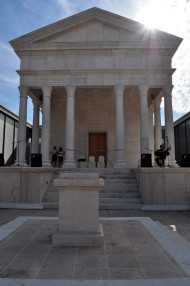Iseum has opened its gates in Szombathely
Szöveg: Gábor Kálmánfi | 2011. augusztus 18. 12:10“The Iseum is a very valuable asset, and we, the citizens of Szombathely are its keepers and depositaries. This piece is our heritage of the common European past; it is not only our property but our task and mission as well” said Minister of Defence Dr. Csaba Hende on Friday, August 12 at the opening ceremony of the Iseum Savariense Archaeological Workshop and Storehouse of Szombathely. In the Roman period, the Szombathely shrine was the centre of the cult of Isis in the Danube-region.
"And this message is that with its culture, Rome very much belongs to us. For Rome is the empire on the ruins of which Europe was created" said Csaba Hende.
The Minister also mentioned in his speech that the Iseum would open new horizons for the main actors of local economy as well. He said the Iseum is "a symbol and at the same time, a working tool".
"It guarantees a living not only for those professionals who work here, but it is also important in terms of tourism. It is a destination for which it is worth visiting Szombathely. Moreover, the Iseum can help us make our carnival nicer and even better, and it can intensify the work of our Roman heritage preserving groups" the leader of the Ministry of Defence closed his speech.
As visitors can learn from the brochure introducing the Iseum, the ruins of the former Isis shrine were revealed thanks to a fortunate accident. During the excavations that began in 195561 and continued from 2001 to the present day, the shrine complex of goddess Isis in Savaria came to light step by step, and the most important collection of sacred finds in Pannonia were found. The enormous shrine complex was built in the first half of the 2nd century B.C., outside the walls of the Roman town, by the Ivy Road, in the place of a former industrial quarter.
Evidence suggests that it was in use until the middle of the 4th century, when the shrine was pulled down and most of its marble carvings were used for lime-burning while its stones were used in construction. The site of the temple became an Early Christian cemetery. From the hundreds of thousands of archaeological finds from the shrine, the huge, oneone and a half ton white marble reliefs that used to decorate the façade of the podium temple, and fractions of statues of gods worshipped in the shrine are of outstanding importance, giving evidence of how strongly cults of Egyptian origin and the worship of Roman Caesars had intertwined.
Experts believe that based on its size, standards of construction, the richness and diversity of material finds found here, the Savaria shrine was the centre of the cult of Isis in the Danube-region.
During the decades that had passed since the restoration following the excavation, the condition of the shrine had deteriorated, visiting the site became dangerous, and based on new researches, the reconstruction plans were outdated. There was a need for a new reconstruction, and in 2007, in the framework of the New Hungary Development Plan Western Transdanubian Operative Program the municipality of Szombathely submitted a tender and won financial support in 2008 for the project called “Construction of the historicalarchaeological quarter of Szombathely, Phase II Reconstruction of the Iseum". Thanks to the successful tender, a plan was made on how to integrate the central shrine and the entire complex into the contemporary environment with a consistent approach. The objectives of the newly created institution are, besides exhibiting the finds of the Iseum, to display relics of religious history in Pannonia and to establish an education base and a scientific workshop on religious history.
Photoes of the author
(Click on our gallery for more pictures!)
